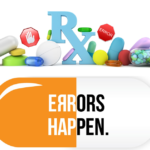Working on ways to Reduce Medication Errors
A medication error is defined as “any preventable event that may cause or lead to inappropriate medication use or patient harm while the medication is in the control of the healthcare professional, patient, or consumer,” according to the National Coordinating Council for Medication Error Reporting and Prevention.
Medication errors occur on a regular basis

There are many types of mistakes that can be made with out the use of modern technology. For example , not using a smart medication box or pill reminder with alarms. Serious harmful results of a medication error include but are not limited to:
- Fatality
- Life threatening reaction
- Short or long term Hospitalization
- Creating a new kind of Disability
- Leads to many kinds of Birth defect.
Sponsored By Med-Q Smart Medication Box with Alarms and Flashing Guides
Looking for ways to reduce medication errors
FDA is always looking for ways to prevent medication errors. The process starts before drugs are approved for marketing. First, the FDA reviews the drug name. Second, they will review to make sure of proper labeling,. Third, correct kind of packaging,. Finally, the boxing needs to show any information that may contribute to preventing medication errors. For example, FDA reviews:
- Looking at the proposed proprietary (brand) name. A focus on trying to minimize the confusion among dozens of similar sounding drug names. FDA uses simulated prescriptions and computerized models. After, the FDA determines the acceptability of proposed proprietary names to hopefully reduce the chances of medication errors associated with product name confusion.
- Container need to be labeled in a way that helps healthcare professionals as well as consumers to pick the correct drug product. When a pill has different strengths (ex. 7 mg, 12 mg, and 20 mg) , the labels should be easy to differentiate. The label design may use different colors or identify the strength in large letters and numbers.
- Prescribing and patient information to ensure the directions for prescribing, preparing, and use are clear and easy to read.
After drugs are approved for marketing in the United States, FDA monitors and evaluates medication error reports. FDA may require a manufacturer to revise the labels, labeling, packaging, product design or proprietary name to prevent medication errors. FDA may also issue communications alerting the public about a medication error safety issue, by way of Drug Safety Communications, Drug Safety Alerts, Medication Guides and Drug Safety Podcasts.
FDA collaborates with external stakeholders, regulators, patient safety organizations such as the Institute for Safe Medication Practices (ISMP), standard-setting organizations such as the U.S. Pharmacopeia, and researchers to understand the causes of medication errors, the effectiveness of interventions to prevent them, and to address broader safety issues that may contribute to medication errors.
Med-Q Medication reminder for Reduce Medication Errors provides More Good Information Links:
Food and Drug Administration: Think it Through: A Guide to Managing the Benefits and Risks of Medicines




